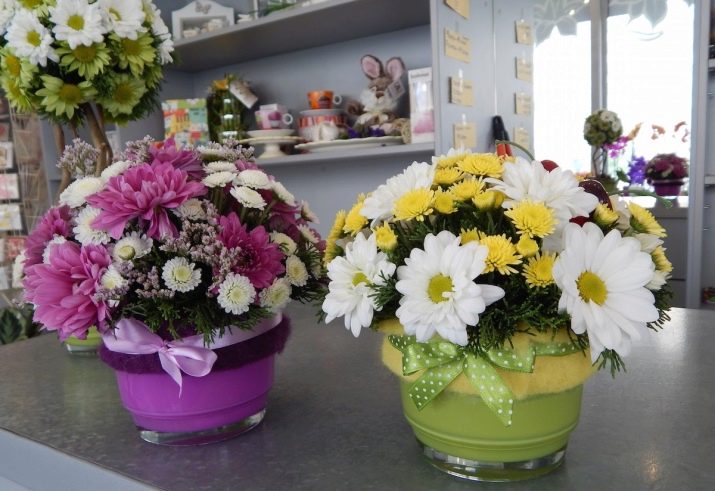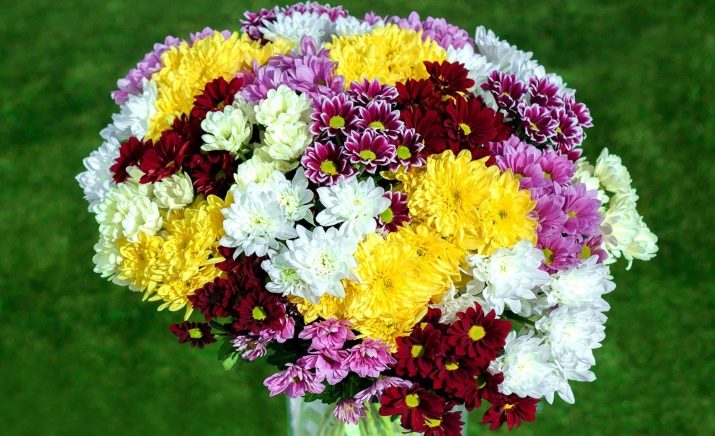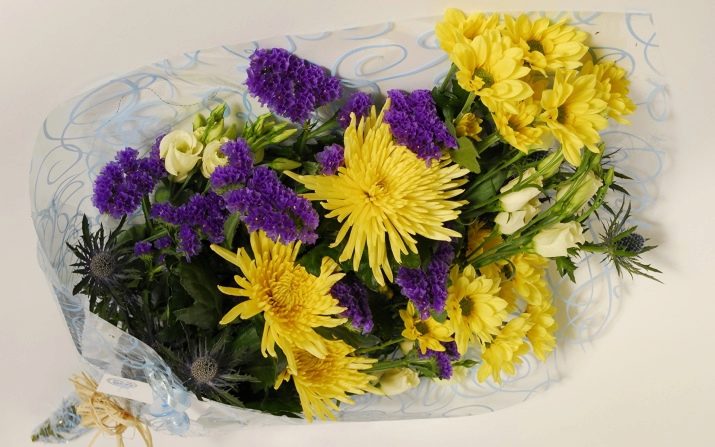Making bouquets of chrysanthemums with your own hands

Like a rose, chrysanthemum is suitable for making original bouquets. It matches both the rose and many other large and small types of flowers.

How to put together a simple composition?
A do-it-yourself chrysanthemum-based bouquet is assembled in several ways. The simplest composition - a bouquet of multi-colored or monochromatic chrysanthemums gathers in a spiral in the form of a circle.

Step by step, this instruction is as follows.
- Place one flower perpendicular to the plane. It will act as a starting point.
- Place the second flower, tilting it slightly - it should not be parallel to the first.
- Place the third and subsequent flowers in the same way, twisting them around the main one. In the simplest case, the buds form a circle.
- Tie the assembled bouquet closer to the middle of the stems, just below this place.
- Use a pruning shear to cut off the ends of the stems if they are unevenly folded. This will give the bouquet a finishing touch.
- Place the created composition in a festive wrapper or decorative paper. It is not recommended to use fabric - the fabric does not have sufficient rigidity for paper and polyethylene.
- Tie the outside of the bouquet with decorative tape.


The composition is ready. Chrysanthemums will be appreciated by school teachers, research assistants, mothers and grandmothers, etc.

Other compositions are as follows.
- Orange flowers wrapped in decorative paper. To add contrast, prepare paper in two different colors to match the tone of the flower petals and stems.

- Chrysanthemums, complemented by ears, in many regions of Russia, close to the north, they will come up to the beginning of the school year, when cereal plants are finally ripe. If there is no wheat field near you, then use dried flowers.

- Chrysanthemums with alstroemeria are good in a combination of different shades.
The greater the contrast, for example, red and white, pink and bluish, the more impression the giver will have on the owner of the bouquet.

- Multicolored chrysanthemums: red, orange, white, yellow, blue shades, with the exception of green, which may be rare in your city or area. You can arrange them sequentially, like the colors of the rainbow.

- Shrub, or bouquet, allow you to form a bouquet from one central branch. Several spray specimens will add more volume to the whole bouquet. The beauty of bush species is that when one bud has already blossomed, others ripen next to it - you get a "long-playing" composition with a continuation.

- Green, yellow and purple chrysanthemums with carnations and roses - one of the most diverse combinations. This option is universal - for all occasions, even on the occasion of March 8th.

You can use only a bush type - the flowers are stacked similarly to copies of a bouquet consisting of only roses. In general, it will not be difficult to arrange a truly exquisite bouquet of any complexity on your own.

What colors should I combine?
Chrysanthemum combines primarily with itself. The alternation of bush and ordinary specimens will give a full range of sensations to the owner of the bouquet.

With roses almost any flowers are combined, including chrysanthemums.
The combination of roses and chrysanthemums should be either contrasting or complementary in color.

Red roses and blue chrysanthemums may not suit most women, especially older ones, due to the difference in color temperature. However, white chrysanthemums and red roses, or vice versa, will be appreciated by almost every woman: red and white can be seen from afar.

Even a white or pale pink rose may not brighten up orange and green chrysanthemums: for example, green should be replaced with hot pink or purple.

Gerbera looks good with chrysanthemums and roses. The shades in the bouquet are chosen mostly bright.

Asters are suitable due to their significant resemblance to chrysanthemums. Both those and others are assigned to the same family. Asters are distinguished by pointed and longer petals, with them the bouquet seems more defiant.

Helpful hints
Flowers that are not cut evenly do not absorb moisture well. They will wilt much faster, as roughly plucked flowers that are not lined up with pruners or scissors will lose their ability to draw water from the vase.

The owner of the bouquet can use sweetened water. Sucrose, like all carbohydrates, is a source of additional energy, and fresh flowers will not be an exception: unblown buds will have time to ripen and open.

Straight folded, without a spiral orientation, the flowers can resemble broom twigs.
It is not recommended to squeeze the buds: located side by side, some of them wrinkle, and the bouquet loses its attractiveness.
This is especially true when the stems are tied up above the middle along their length.

Inexperienced florists start with simple, monochromatic and single-color compositions. Uniformity is an element of future diversity and the first step towards successful, regular flower sales. A huge help here is a home garden-flower garden.

For small bouquets, it is preferable to use mainly wildflowers. Large species - chrysanthemums, roses, a few zinnias in a bouquet - will need to be significantly shortened.

It is not recommended to use more than three shades in the contrasting composition of the composition - too motley, lurid combination may come out. Different types can be chosen in the same tone, for example, yellow roses, chrysanthemums, tulips and asters.

You can make a red-yellow, red-white or orange-white bouquet. The red and white is a reference to cream and strawberries. For example, when a guy invited a girl to a cafe and treated her to ice cream with strawberries, he, deciding to give the joint evening a single style, will give her a very beautiful bouquet of scarlet roses and white chrysanthemums. The final completeness of the gift will be given by a beautiful bag or box, which contains a bouquet wrapped in a gift wrap.

The features of making bouquets of chrysanthemums can be found in the following video.








